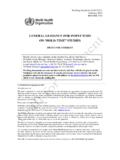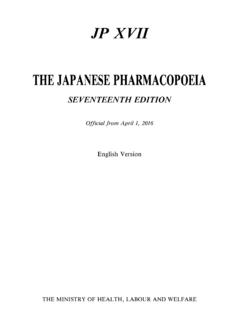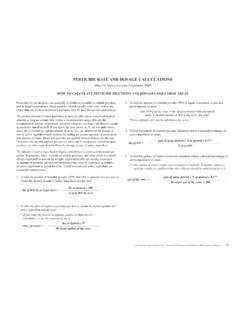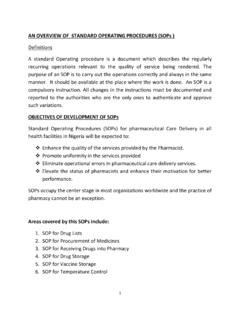Transcription of Quality by Design (QbD) in Pharmaceutical Industry: Tools ...
1 Vol. 4, Issue 11 | PharmaTutor PRINT ISSN: 2394-6679 | E-ISSN: 2347-7881 Quality by Design (QbD) in Pharmaceutical Industry: Tools , Perspectives and Challenges Arijit Gandhi*1, Chandrani Roy2 1 Production cum Quality Manager, Kras Pharmaceuticals Pvt. Ltd., Fatwah, India. 2 Department of pharmaceutics, Gupta College of Technological Sciences, Asansol, West Bengal, India. ABSTRACT Recently the concept of Quality by Design (QbD) gaining much attention among Pharmaceutical industries for maintaining Quality . It serves as a bridge between industry and drug regulatory authorities to move towards a scientific, risk based, holistic and proactive approach for development of Pharmaceutical product.
2 It mainly covers designing and developing formulations and manufacturing processes to ensure predefined product Quality . Some of the QbD elements include defining target product Quality profile, designing product and manufacturing processes, identifying critical Quality attributes, process parameters, and sources of variability & controlling manufacturing processes to produce consistent Quality over time The purpose of this article is to discuss the concept of Pharmaceutical Quality by Design and describe how it can be help to ensure Pharmaceutical Quality & drug development.
3 Keywords: Quality by Design (QbD), Target Product Quality Profile (TPQP), Critical Quality Attribute (CQA), Critical Process Parameter (CPP), Quality Risk Management (QRM). INTRODUCTION Pharmaceutical industry is constantly searching the ways to ensure and enhance product safety, Quality and efficacy. However, drug recalls, manufacturing failure cost, scale up issues and regulatory burden in recent past produce huge challenge for industry. In traditional, the product Quality and performance are predominantly ensured by end product testing, with limited understanding of the process and critical process parameters.
4 Regulatory bodies are therefore focusing on implementing Quality by Design (QbD), a science based approach that improves process understanding by reducing process variation and the enabling process-control strategies. Instead of relying on finished product testing alone, QbD provides insights upstream throughout the development process. As a result, a Quality issue can be efficiently analyzed and its root cause quickly identified. QbD requires identification of all critical formulation attributes and process parameters as well as determining the extent to which any variation can impact the Quality of the finished product [1-3].
5 In the area of Pharmaceutical Quality ; Food and drug administration (FDA) announced proposed amendments to "Current Good Manufacturing Practices" (cGMP) in 2002, with an emphasis on establishing a 21st century outlook on Pharmaceutical manufacturing in order to establish a more systematic science and risk based approach to the development of Pharmaceutical products. The initiation of the cGMPs for the 21st Century and the publication of the Process Analytical Technology (PAT) guidance in 2004 by the FDA gave the way for the modernization of the Pharmaceutical industry. After that, ICH (International Conference on Harmonization) discussions in July 2003 (Brussels) agreed a consensus vision to develop a harmonized Pharmaceutical Quality system applicable across the life cycle of the product emphasizing an integrated approach to risk management and science.
6 All the major objectives with regard to Quality issues are being addressed by the ICH guidelines. The three ICH guidelines which throw light upon Quality -by- Design and related aspects include Q8 Pharmaceutical development, Q9 Pharmaceutical risk management and Q10 Pharmaceutical Quality systems. In fact, the How to cite this article: Gandhi A, Roy C; Quality by Design (QbD) in Pharmaceutical Industry: Tools , Perspectives and Challenges; PharmaTutor; 2016; 4(11); 12-20 12 Vol. 4, Issue 11 | PharmaTutor PRINT ISSN: 2394-6679 | E-ISSN: 2347-7881 ICH guideline Q8 is sub-divided into two parts: part one deals with Pharmaceutical development and Part II is the annex to the guideline which states the principles for Quality -by- Design .
7 According to ICH Q8(R2) guideline, Quality by Design (QbD) is A systematic approach to development that begins with predefined objectives and emphasizes product and process understanding and Process control, based on sound science and Quality Risk Management [4-6]. QbD describes a Pharmaceutical development approach referring to formulation Design and development and manufacturing processes to maintain the prescribed product Quality . Guidelines and mathematical models are used to ensure the establishment and use of the knowledge on the subject in an independent and integrated way [7].
8 In order to initiate a successful QbD program, the first step is to identify those process parameters that are essential to product Quality and develop well validated analytical methodologies to monitor those parameters. The objective of this review article is therefore to provide a comprehensive understanding on various aspects of QbD, along with addressing the concerns related to its implementation. KEY CHARACTERISTICS OF QBD [8-9] A tool for focused & efficient drug development Dynamic and systematic process Relies on the concept that Quality can be built in as a continuum It is applicable to Drug Product and Drug Substance development (chemicals / biologics) It is applicable to analytical methods Can implemented partially or totally Can be used at any time in the life cycle of the Drug Always encouraged by Regulators.
9 BENEFITS OF QBD [10-12] Eliminate batch failures Minimize deviations and costly investigations Avoid regulatory compliance problems Empowerment of technical staff Efficient, agile, flexible system Increase manufacturing efficiency, reduce costs and project rejections and waste Build scientific knowledge base for all products Better interact with industry on science issues Ensure consistent information Incorporate risk management Reduce end-product testing Speed-up release decision KEY ELEMENTS OF QbD ICH Q8: Pharmaceutical Development discusses the various elements of Quality by Design . These in combination with the enablers form the fundamental basis for the QbD approach to development.
10 Figure 1 provides a pictorial representation of the typical elements of QbD. It involves the following key elements during Pharmaceutical development 1. Define the Quality Target Product Profile 2. Identify the Quality Attributes 3. Perform a Risk (Assessment) Analysis 4. Determine the Critical Quality Attributes and Critical Process Parameters 5. Determine the Design Space 6. Identify a Control Strategy Fig 1. Overview of QbD. 13 Vol. 4, Issue 11 | PharmaTutor PRINT ISSN: 2394-6679 | E-ISSN: 2347-7881 Quality TARGET PRODUCT PROFILE (QTTP) According to ICH Q8(R2), QTTP is Prospective summary of the Quality characteristics of a drug product that ideally will be achieved to ensure the desired Quality , taking into account safety and efficacy of the drug product.




